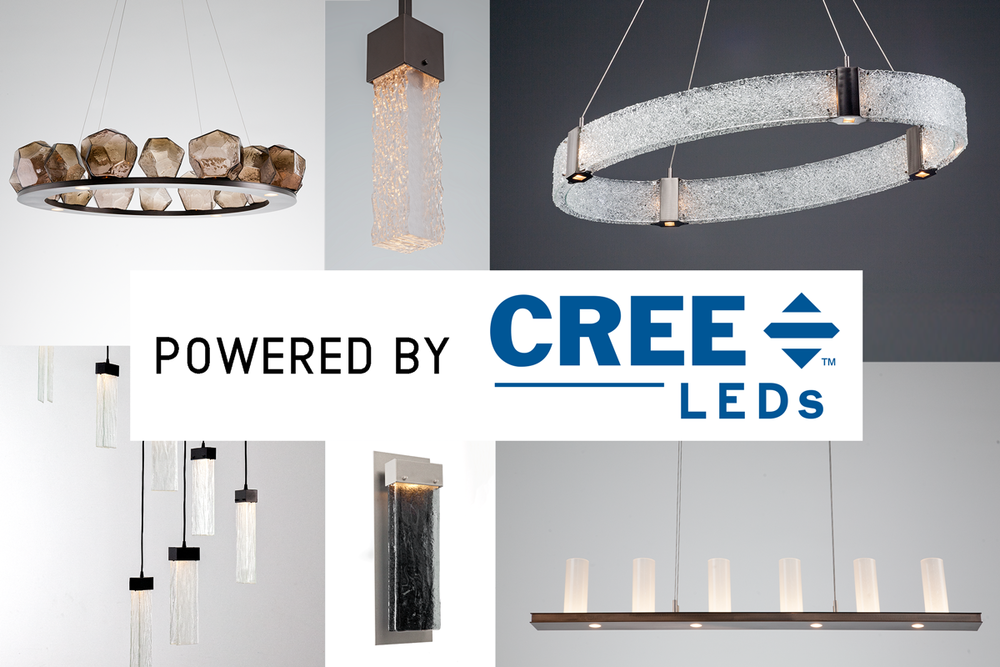HAMMERTON & CREE LEDs: BETTER LIGHT

Our superior quality standards at Hammerton demand the very best in everything we do. So when it came to adopting an LED platform, we were patient. Our clients expected the highest performance level from their Hammerton fixtures, but the benefits of energy efficiency and longer life that heralded consumer adoption of solid state lighting in those early days weren’t enough to get them excited. Simply put, they wanted better light.
So we waited and watched while the industry evolved and the technology became more reliable — in light output, color consistency, light quality, dimming performance, and so on. And it finally arrived. Today, we are thrilled to announce that all Hammerton LED products are now powered with CREE® Integrated LEDs.
As a U.S. manufacturer of superior quality LEDs, CREE is recognized worldwide as a market-leading innovator in LED technology. Hammerton fixtures with integrated LED use the highest quality 2 SDCM, 90+ CRI LEDs available, with either 2,700K or 3,000K CCT powered by drivers that are able to dim to 1%. In fact, Hammerton is the only custom decorative lighting brand powered by CREE LEDs.
What does all this mean, and why is it important? LED technology can be a mindbender, but here are the key points:
1. Why does ‘2 SDCM’ matter? Basically, SDCM refers to color consistency as it relates to color temperature. Believe it or not, you can frequently see color differences between LEDs that are ostensibly the same color. This is measured in standard deviations of color matching, or SDCM. The greater the SDCM, the easier it is to see color differences. The human eye generally starts seeing color differences at the 3 SDCM level, and the vast majority of LEDs used in the lighting industry are 4-7 SDCM.
2. Why does ‘90+ CRI’ matter? “CRI” stands for Color Rendering index, and it measures a light source’s ability to show colors realistically or naturally compared to a familiar reference such as incandescent light or daylight. For example, the CRI of filament bulb lamps is 95-100, while cool white fluorescent lamps have a CRI of 62. So the lower the CRI value, the less natural some colors may appear. Many decorative lighting brands use LEDs with 70 CRI or less because they’re less expensive and more widely available.
3. Why does ‘2,700-3,000K’ CCT matter? “CCT” stands for color correlated temperature or color corrected temperature, and refers to the tone of ‘white light’ that is emitted from an artificial light source. A lower CCT of 2,000K is a hotter orange-yellow color, while a higher CCT of 4,000K is a cooler blue color. 2,700-3,000K is the “warm white” color typically associated with filament bulb lighting, and is considered ideal for most residential and hospitality applications.
4. Why does Dimming matter? Dimming has been one of the greatest challenges faced by lighting manufacturers who incorporate LEDs in their designs. The driver, rather than the LED, is what determines a fixture’s dimming performance. Early on in the adoption of solid state lighting, most LEDs flickered and sputtered when operated by a standard dimmer, while others dimmed only to about 10% of their light output. Hammerton LED fixtures use drivers that can be operated by both forward and reverse phase dimmers while dimming smoothly to 1%. This takes the hassle out of retrofitting a space with a beautifully efficient LED light fixture.
If you’d like to learn more, give us a call.